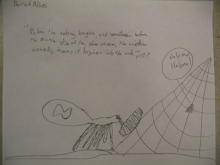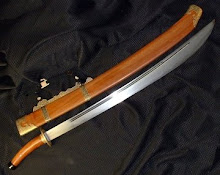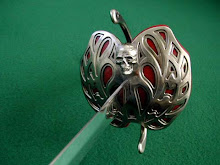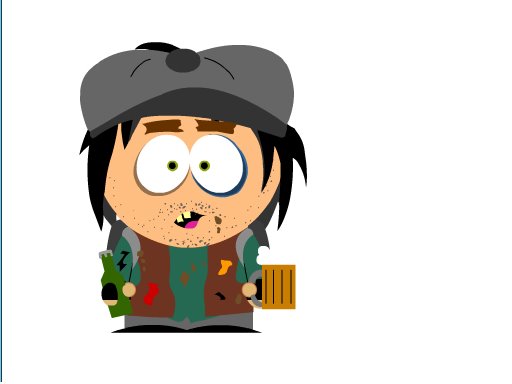10. Free food.
9. The random chaos of in class arguments.
8. Hissing at late people.
7. Searcy’s awesomeness.
6. The Medieval Banquet
5. Random field trips to graveyards.
4. The general exuberance of all the students.
3. King Lear is fun! I love King Lear.
2. The Rape of the Lock video.
1. Random thirty-minute unsupervised movie making!!
Tuesday, May 27, 2008
Friday, May 23, 2008
Top Three Melee Weapons
Top Three Melee Weapons
The criteria for my choices are blade design, defensive opportunities, reach, and wounding capabilities. Blade design means the blade of the weapon is suitable for its offensive style; Defensive opportunity means the weapons flexibility and durability in the face of an opponent’s attack. Reach means the length of the blade and its ability to wound at a longer distance and wounding capabilities means the severity of the damage caused by a regular attack. In addition to the basic requirements, the overall looks of the weapon and the skill necessary to wield it will be taken into account.
# 3: Chinese Broadsword
The Chinese broadsword is a difficult to master curved weapon often used by Shaolin Monks in their ancient monasteries in northwestern China. The hilt often has a red cloth attached to it, near the pommel, and rings are often punched through the back edge. Both of these modifications were invented by the Shaolin monks to give their opponent’s some indication as to when the blade was coming. The Shaolin were know to be astonishingly fast with their weapons and were famous mercenaries in ancient China. The Blade is made primarily for slashing and hacking motions, which the Shaolin execute with unbelievable speed. The Blade is very rigid to add power to the cuts and, as such, would shatter easily if hit hard with a heavy weapon. The blade itself isn’t very long, as the Shaolin fighting style works very close to the body and a long blade would injure its wielder. The Shaolin make up for this with their blinding speed and agility, but an average swordsman may find this to make things more complicated. The weapon itself lacks and real weight to cause a severely damaging wound with a simple cut, but the agility of the weapon make large numbers of attacks in a short period of time possible. The weaknesses of the blade in the hands of anyone but a Shaolin monk combined with its natural strengths make this my third favorite melee weapon.
# 2: Rapier
Rapiers are long, narrow thrusting swords common in the renaissance period. They evolved slowly during the late middle ages as gunpowder made armor more and more useless. The name “Rapier” comes from the Spanish word, espada ropera, which means “Dress sword.” There is over fifty known styles of rapier, whose manuals still exist in modern times. The rapier is the ancestor of the modern epee and foil used in Olympic fencing. The very long blade tapers to a very fine point, sharp enough to pierce through 2 inches of armor grade steel without using a lot of force. The blade itself is very narrow, making a direct block almost pointless. However, the flexibility of the blade makes using the guard to turn an opponent’s blade while retaliating, called a riposte, very easy. Modern movie sword fighting is loosely based on the look of to good fencers going at it, parrying and reposting, then blocking the opponent’s parry and riposte. The reach of the blade is huge, often at 48 inches of blade past the guard. This is approximately the length of a two handed longsword’s blade, although the rapier weighs several pounds less. The offensive capabilities of a rapier are mostly limited to thrusting, although cuts can be somewhat effective. Another thing about the rapier is the guard can be nothing more than a steel bowl covering the hilt all the way to a gilt tangle of high grade steel bars made to resemble a face. The looks of a rapier, its speed and agility, and the fact that I am trained in a late renaissance period style of fencing created by Maestro Rodolfo Cappo Ferro of Italy, who is considered to be the Grandfather of modern fencing, make this my second favorite melee weapon.
# 1: The Broadsword
The Broadsword is an ancient and venerated weapon whose earliest forms were among the first sword designs created by humans. Some form of the straight, broad bladed weapon can be found in almost every culture in the world. The Romans created the first uniformly similar broadsword in the gladius, the sidearm of Rome’s elite infantry, the legionnaires. The weapon further evolved during the middle ages after the fall of Rome, during the first invasions by the Angles, the Saxons and the Jutes. These three groups brought their own versions of the broadsword, which the Celts defending Briton combined with the design of the Gladius, giving the weapon a longer and heavier blade with a pointed tip for thrusting. This is the basis for the broadswords wielded by the knights of the middle ages. The Scots worked further on this design, refining the design and adding a basket to the hilt to protect the wielders hand from attacks. The blade is heavy and well suited to chopping and hacking attacks although lighter blades were known. The blade maintains a decent level of flexibility on designs made after the discovery of steel, and has the blade strength to take many heavy hits without too much damage. The length of the broadsword varies according to design, but seldom goes longer than 38 inches, and that rarely. The wounding power of the broadsword is almost unmatched among one handed swords. These factors combine to make the broadsword my favorite melee weapon.
The criteria for my choices are blade design, defensive opportunities, reach, and wounding capabilities. Blade design means the blade of the weapon is suitable for its offensive style; Defensive opportunity means the weapons flexibility and durability in the face of an opponent’s attack. Reach means the length of the blade and its ability to wound at a longer distance and wounding capabilities means the severity of the damage caused by a regular attack. In addition to the basic requirements, the overall looks of the weapon and the skill necessary to wield it will be taken into account.
# 3: Chinese Broadsword
The Chinese broadsword is a difficult to master curved weapon often used by Shaolin Monks in their ancient monasteries in northwestern China. The hilt often has a red cloth attached to it, near the pommel, and rings are often punched through the back edge. Both of these modifications were invented by the Shaolin monks to give their opponent’s some indication as to when the blade was coming. The Shaolin were know to be astonishingly fast with their weapons and were famous mercenaries in ancient China. The Blade is made primarily for slashing and hacking motions, which the Shaolin execute with unbelievable speed. The Blade is very rigid to add power to the cuts and, as such, would shatter easily if hit hard with a heavy weapon. The blade itself isn’t very long, as the Shaolin fighting style works very close to the body and a long blade would injure its wielder. The Shaolin make up for this with their blinding speed and agility, but an average swordsman may find this to make things more complicated. The weapon itself lacks and real weight to cause a severely damaging wound with a simple cut, but the agility of the weapon make large numbers of attacks in a short period of time possible. The weaknesses of the blade in the hands of anyone but a Shaolin monk combined with its natural strengths make this my third favorite melee weapon.
# 2: Rapier
Rapiers are long, narrow thrusting swords common in the renaissance period. They evolved slowly during the late middle ages as gunpowder made armor more and more useless. The name “Rapier” comes from the Spanish word, espada ropera, which means “Dress sword.” There is over fifty known styles of rapier, whose manuals still exist in modern times. The rapier is the ancestor of the modern epee and foil used in Olympic fencing. The very long blade tapers to a very fine point, sharp enough to pierce through 2 inches of armor grade steel without using a lot of force. The blade itself is very narrow, making a direct block almost pointless. However, the flexibility of the blade makes using the guard to turn an opponent’s blade while retaliating, called a riposte, very easy. Modern movie sword fighting is loosely based on the look of to good fencers going at it, parrying and reposting, then blocking the opponent’s parry and riposte. The reach of the blade is huge, often at 48 inches of blade past the guard. This is approximately the length of a two handed longsword’s blade, although the rapier weighs several pounds less. The offensive capabilities of a rapier are mostly limited to thrusting, although cuts can be somewhat effective. Another thing about the rapier is the guard can be nothing more than a steel bowl covering the hilt all the way to a gilt tangle of high grade steel bars made to resemble a face. The looks of a rapier, its speed and agility, and the fact that I am trained in a late renaissance period style of fencing created by Maestro Rodolfo Cappo Ferro of Italy, who is considered to be the Grandfather of modern fencing, make this my second favorite melee weapon.
# 1: The Broadsword
The Broadsword is an ancient and venerated weapon whose earliest forms were among the first sword designs created by humans. Some form of the straight, broad bladed weapon can be found in almost every culture in the world. The Romans created the first uniformly similar broadsword in the gladius, the sidearm of Rome’s elite infantry, the legionnaires. The weapon further evolved during the middle ages after the fall of Rome, during the first invasions by the Angles, the Saxons and the Jutes. These three groups brought their own versions of the broadsword, which the Celts defending Briton combined with the design of the Gladius, giving the weapon a longer and heavier blade with a pointed tip for thrusting. This is the basis for the broadswords wielded by the knights of the middle ages. The Scots worked further on this design, refining the design and adding a basket to the hilt to protect the wielders hand from attacks. The blade is heavy and well suited to chopping and hacking attacks although lighter blades were known. The blade maintains a decent level of flexibility on designs made after the discovery of steel, and has the blade strength to take many heavy hits without too much damage. The length of the broadsword varies according to design, but seldom goes longer than 38 inches, and that rarely. The wounding power of the broadsword is almost unmatched among one handed swords. These factors combine to make the broadsword my favorite melee weapon.
Wednesday, May 7, 2008
Lyrical Analysis
Smells like Teen Spirit by Nirvana
I enjoy the lyrics of this song because they hit the teenage mentality very well. The whole song is based around the rebellious nature and feeling of invincibility that every youth goes through. This is highlighted in the lines that go like this:
Load up on guns and bring your friends
It's fun to lose and to pretend
She's over bored and self assured
Oh no, I know a dirty word
It also highlights the common held belief of teenagers that they will always be with their friends, although most of the time they split apart after grad. This is shown in the verse that reads:
I'm worse at what I do best
And for this gift I feel blessed
Our little group has always been
And always will until the end
This hits close to home, as my own friends form childhood and I are slowly drifting apart, due to my moving away from them and the invisible wedge driven in by my diagnosis with diabetes a year and a half ago. We still hang out as often as possible, but it is highly unlikely the “frat house” we talked about starting will probably never happen.
I enjoy the lyrics of this song because they hit the teenage mentality very well. The whole song is based around the rebellious nature and feeling of invincibility that every youth goes through. This is highlighted in the lines that go like this:
Load up on guns and bring your friends
It's fun to lose and to pretend
She's over bored and self assured
Oh no, I know a dirty word
It also highlights the common held belief of teenagers that they will always be with their friends, although most of the time they split apart after grad. This is shown in the verse that reads:
I'm worse at what I do best
And for this gift I feel blessed
Our little group has always been
And always will until the end
This hits close to home, as my own friends form childhood and I are slowly drifting apart, due to my moving away from them and the invisible wedge driven in by my diagnosis with diabetes a year and a half ago. We still hang out as often as possible, but it is highly unlikely the “frat house” we talked about starting will probably never happen.
Friday, May 2, 2008
"1984" by George Orwell and "Stranger" by Ghegi25
Stranger
By Ghegi25
I stand in front of the mirror
And wipe the fog away
My vision is still hazy
From ridding myself this way
My hair is all in tangles
My eyes are filled with tears
I wipe the warm tears away
As if trying to rid myself of my fears
I'm ashamed of what I have done
But it hurts me even more
I can't make myself stop doing it
Even though I know what's in store
It has taken over my mind
It is eating away at my soul
My throat burns with anger
While my stomach growls even more
I am still looking in the mirror
Yet I don't know who I see
All that I know
Is this sad sight couldn't be me
I grip the edge of the counter
So tightly that my knuckles turn white
I want to scream out in anger
At this ugly sight
It's your fault I hiss
That I do this to myself
If only you didn't look this way
I would be in better health
I cover the image in the mirror
With the palm of my hand
And notice a cut on my finger
That I never knew I had
I grab my hand in anger
Or is it more like fright
I'm just so shocked
To see this sight
I laugh and then I cry
Then crumble to the floor
Suddenly aware of my problem
Like I never was before
How did this happen to me?
How did I become a statistic?
I thought that I was strong,
I thought I was better than that
My head throbs in anger
My throat burns with pain
My finger loses a drop of blood
And Nothing is what I have gained
The poem “Stranger”, by Ghegi25, relates to many of the more despairing themes common in “1984” by George Orwell. The author of “Stranger, hidden behind a pseudo name, despairs about the elements of modern society that cause people to lose themselves in a mad quest for acceptance from others. The wording of stanza 3 demonstrates this well, saying
“I'm ashamed of what I have donebut it hurts me even moreI can't make myself stop doing itEven though I know what's in store”
This relates to “1984” in that Winston feels that the party’s tenements are causing him to lose his identity, as it has so many others. The author of “Stranger” feels like he or she is powerless to change anything by herself and that he or she won’t find any help from others, as demonstrated by stanza 12, which reads
“My head throbs in angermy throat burns with painmy finger loses a drop of bloodAnd Nothing is what I have gained”
This feeling is reflected in “1984” in Winston’s eventual defeat at the hands of the Ministry of Love, and his giving in entirely to the Party’s contradictory and mind washing tenements.
By Ghegi25
I stand in front of the mirror
And wipe the fog away
My vision is still hazy
From ridding myself this way
My hair is all in tangles
My eyes are filled with tears
I wipe the warm tears away
As if trying to rid myself of my fears
I'm ashamed of what I have done
But it hurts me even more
I can't make myself stop doing it
Even though I know what's in store
It has taken over my mind
It is eating away at my soul
My throat burns with anger
While my stomach growls even more
I am still looking in the mirror
Yet I don't know who I see
All that I know
Is this sad sight couldn't be me
I grip the edge of the counter
So tightly that my knuckles turn white
I want to scream out in anger
At this ugly sight
It's your fault I hiss
That I do this to myself
If only you didn't look this way
I would be in better health
I cover the image in the mirror
With the palm of my hand
And notice a cut on my finger
That I never knew I had
I grab my hand in anger
Or is it more like fright
I'm just so shocked
To see this sight
I laugh and then I cry
Then crumble to the floor
Suddenly aware of my problem
Like I never was before
How did this happen to me?
How did I become a statistic?
I thought that I was strong,
I thought I was better than that
My head throbs in anger
My throat burns with pain
My finger loses a drop of blood
And Nothing is what I have gained
The poem “Stranger”, by Ghegi25, relates to many of the more despairing themes common in “1984” by George Orwell. The author of “Stranger, hidden behind a pseudo name, despairs about the elements of modern society that cause people to lose themselves in a mad quest for acceptance from others. The wording of stanza 3 demonstrates this well, saying
“I'm ashamed of what I have donebut it hurts me even moreI can't make myself stop doing itEven though I know what's in store”
This relates to “1984” in that Winston feels that the party’s tenements are causing him to lose his identity, as it has so many others. The author of “Stranger” feels like he or she is powerless to change anything by herself and that he or she won’t find any help from others, as demonstrated by stanza 12, which reads
“My head throbs in angermy throat burns with painmy finger loses a drop of bloodAnd Nothing is what I have gained”
This feeling is reflected in “1984” in Winston’s eventual defeat at the hands of the Ministry of Love, and his giving in entirely to the Party’s contradictory and mind washing tenements.
Subscribe to:
Comments (Atom)











